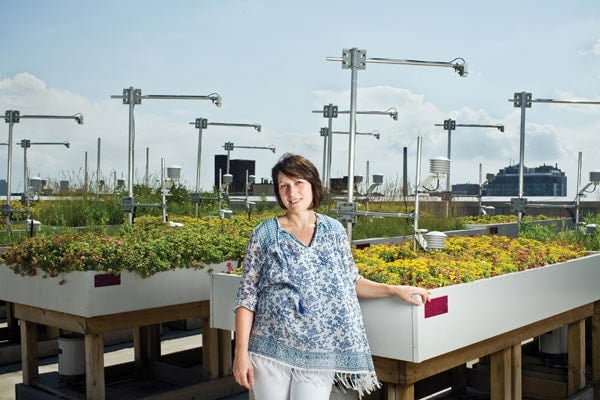
Making green roofs greener
Published: December 5, 2013
Did you know that Toronto is covered in green roofs? Well, it’s covered in roofs that were once green. Nobody knows if they still are.
This is the problem that motivates Professor Liat Margolis of the John H. Daniels Faculty of Architecture, Landscape and Design at the University of Toronto.
Thanks to a 2009 bylaw that mandated green roofs for new buildings over 2,000 square metres, developers city-wide are blanketing their buildings in plants. But since the city has no power of inspection, no one knows if the roofs are thriving.
Worse, no one knows if they’re doing what they’re supposed to: help with water retention and cooling in the urban jungle.
Cities, with their miles of impervious surfaces, aren’t able to absorb water when there’s a storm. They’re also hotter than the surrounding countryside. Green roofs have the potential to help with both these problems. Soil absorbs water, and plants, through the process of evapotranspiration, act as miniature air conditioners.
Sounds great in theory, right? But the problem is it’s all theory: no one has comprehensively tested green roofs in Toronto.
“Toronto has a very particular climate,” says Margolis. “We have a much bigger range between hot and cold and a lot more rainfall than most areas that have done green roof studies.”
Margolis is the director of an ambitious project situated on the roof of the Daniels building, where she and a multi-disciplinary team of professors, students and representatives from industry have constructed 33 test beds designed to hit upon the ideal recipe for optimizing green roofs in Toronto. The group is testing four variables: soil content, soil depth, amount of irrigation and type of plant.
“What you might design for Toronto is different from what you would design for Dallas,Texas,” she says.
And yet green roofs across North America are largely the same. For example, the dominant practice is to plant a species called sedum. It comes in mats that are unrolled – like sod – for an instant green roof. Its drought-tolerance, says Margolis, may actually be a disadvantage when it comes to cooling. Sedum has evolved to hold onto as much water as it can, and it doesn’t evapotranspire during the day, which is exactly when the cooling effects of green roofs are needed. And because it’s a functional monoculture, made up of plants having a similar growth habit, when it’s struck by pests or disease, the entire roof dies.
By contrast, Margolis and her team are testing a native mixture of meadow grasses and flowers that are diverse and known for their ability to release moisture into the air. The team is doing the same thing with their other variables. By testing various combinations, they hope to improve on the industry standard. How will they know they’ve succeeded? Each bed is outfitted with eight sensors that measure everything from rate of water runoff after a storm to moisture of the soil to air temperature above the bed. A weather station collects data on wind speed and direction, temperature, solar radiation and humidity. The instruments take readings every five minutes, and data are combined with field observations of the plants.
The test beds are monitored year-round to assess change over time. Armed with results from their lab in the sky, Margolis hopes the team will be able to influence the establishment of a made-in-Toronto green roof construction standard.
Margolis wants people to understand that green roofs are living systems.
“It’s a mistake to think of green roofs as a one-size-fits-all product that you can cut and paste from one region to another like a tile.”
Her bigger goal is to get people asking the right questions about sustainable cities.
“The problem with sustainability is that everyone thinks there’s a downloadable checklist, a quick answer for everything. But we’re talking about complex, comprehensive, dynamic systems. There are no easy answers.”
Jenny Hall is a writer with U of T's research and innovation magazine, Edge, where this story originally appeared. To read more Edge stories, visit http://www.research.utoronto.ca/edge/fall2013/.



